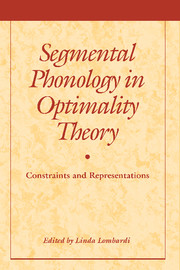Book contents
- Frontmatter
- Contents
- List of Contributors
- Introduction
- I The Content of Representations
- II The Content of Constraints
- 5 Austronesian Nasal Substitution Revisited: What's Wrong with *NC (and What's Not)
- 6 A Critical View of Licensing by Cue: Codas and Obstruents in Eastern Andalusian Spanish
- 7 Segmental Unmarkedness versus Input Preservation in Reduplication
- III The Structure of the Grammar: Approaches to Opacity
- Index
7 - Segmental Unmarkedness versus Input Preservation in Reduplication
Published online by Cambridge University Press: 05 July 2014
- Frontmatter
- Contents
- List of Contributors
- Introduction
- I The Content of Representations
- II The Content of Constraints
- 5 Austronesian Nasal Substitution Revisited: What's Wrong with *NC (and What's Not)
- 6 A Critical View of Licensing by Cue: Codas and Obstruents in Eastern Andalusian Spanish
- 7 Segmental Unmarkedness versus Input Preservation in Reduplication
- III The Structure of the Grammar: Approaches to Opacity
- Index
Summary
Introduction
Reduplication creates new words by affixing a copy of all or part of the base word. This chapter discusses types of reduplication from Chinese languages that differ in two ways from the most familiar and prototypical cases. First, it is not obvious which piece of the output is the base and which is the affixed copy, and instead the outputs look more like compounds of a word with itself. Second, and the focus of this chapter, the copies are imperfect, with various segments from the input being replaced by fixed segments, [1] in onsets, [i] in nuclei, and [?] or [ŋ] in codas. I argue that these segmental replacements are the unmarked segments for these syllabic positions, and that they represent instances of The Emergence of The Unmarked (TETU), as discussed in Alderete et al. (1999).
After a survey of the data, I begin by laying out the basic analysis of reduplication as a response to two constraints, Alliterate and Rhyme. I then show how the ranking of these with respect to segmental markedness constraints gives rise to the segmental changes. In the next section I discuss the particular choice of unmarked segments, and propose a set of markedness constraints. The final two sections discuss cases where segmental markedness is violated on the surface in that the replacement segments do not appear to be the most unmarked ones. In the first case, a special requirement of secret languages forces an increase in markedness. In the second case, conflicting markedness constraints interact with the secret language constraint to produce surface marked segments.
- Type
- Chapter
- Information
- Segmental Phonology in Optimality TheoryConstraints and Representations, pp. 206 - 228Publisher: Cambridge University PressPrint publication year: 2001
- 4
- Cited by

